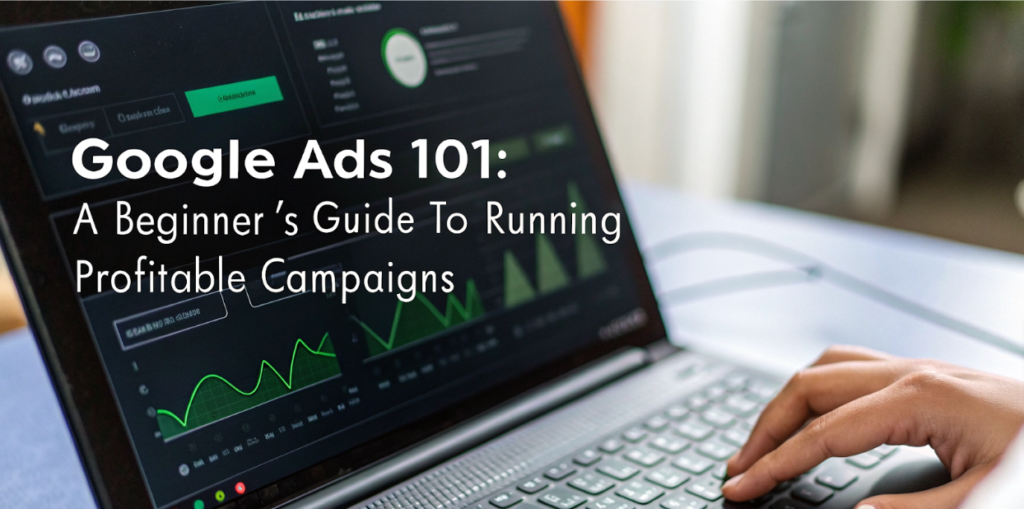If you’ve ever searched for something on Google and clicked on one of those top results labeled ‘Sponsored,’ congrats you’ve just encountered Google Ads in action. But how do you go from being the searcher to the seller, using Google Ads to attract leads, drive sales, and grow your business?
This guide is your no-nonsense introduction to running profitable Google Ads campaigns. Whether you’re an SME, a startup, or an ambitious brand looking to scale, let’s break it down into practical, actionable steps without the jargon overload.
Why Google Ads?
Google Ads gives you access to billions of searches per day, meaning you can target people who are actively looking for what you offer. Unlike social media ads, where you’re hoping to catch someone’s attention mid-scroll, Google Ads places your business in front of high-intent customers people who are already interested and ready to take action.
Step 1: Choosing Your Campaign Type
Before diving in, you need to pick the right type of Google Ads campaign:
- Search Ads – The classic text-based ads that appear in search results when someone looks for a product or service.
- Display Ads – Visual banners that pop up across Google’s vast Display Network, perfect for brand awareness.
- Shopping Ads – Product-based ads that showcase your items directly in Google Shopping results.
- YouTube Ads – Video ads that play before, during, or after YouTube content.
- Performance Max – Google’s AI-driven campaign that optimizes across multiple channels for maximum efficiency.
Each type serves a unique purpose, so the best choice depends on your business goals.
Step 2: Keyword Targeting – Finding the Right Customers
Google Ads thrives on keywords the exact words and phrases people type into search.
✅ Broad Match – Casts a wide net, showing ads for loosely related searches (good for awareness but can burn budget quickly).
✅ Phrase Match – Shows ads for searches containing a key phrase, giving better control over relevance.
✅ Exact Match – Restricts ads to users who type in your exact keyword, ensuring hyper-targeted results.
✅ Negative Keywords – Prevents your ads from appearing for irrelevant searches, saving you from wasted clicks.
The goal? Find the sweet spot keywords with strong intent and reasonable competition to get the best return on your ad spend.
Step 3: Crafting Click-Worthy Ads
Google Ads isn’t just about bidding on keywords it’s about standing out from the competition. Your ad copy should be clear, compelling, and customer-focused.
🎯 Headline – Keep it simple, benefit-driven, and packed with relevant keywords.
🎯 Description – Highlight why your offer is better and what problem you’re solving.
🎯 CTA (Call to Action) – Be direct about what action users should take: Get a Quote, Buy Now, Learn More.
🎯 Ad Extensions – Use site links, callouts, and structured snippets to provide extra information and credibility.
Step 4: Setting Your Budget & Bidding Strategy
Google Ads operates on an auction system, meaning you bid for ad placements. Here are your main options:
💰 Manual Bidding – You control the maximum CPC (cost-per-click) for better budget allocation.
💰 Enhanced CPC – Google adjusts your bids automatically to optimize conversions.
💰 Target ROAS – Google optimizes bids to achieve a specific return on ad spend.
💰 Maximize Conversions – Google optimizes your spending to generate the most conversions possible.
The key? Start small, monitor performance, and scale what works.
Step 5: Tracking & Optimizing Performance
Running ads without tracking is like throwing darts in the dark. Google provides powerful tools to measure success and refine performance:
📊 Google Analytics – Helps you track user behavior and conversions.
📊 Google Ads Dashboard – Monitor clicks, impressions, and cost per conversion in real time.
📊 A/B Testing – Experiment with different ad creatives, headlines, and keyword combinations to identify the best performer.
📊 Quality Score – Google rates your ads based on relevance, impacting cost and ranking.
The iRebel UK Approach
At iRebel UK, we don’t believe in running ads just for the sake of it. Every campaign we manage is backed by data, fine-tuned for performance, and designed to drive actual business growth.If you’re ready to stop guessing and start growing, let’s craft a Google Ads strategy that actually works.

